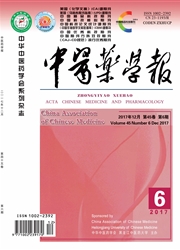

 中文摘要:
中文摘要:
目的:研究不稳定型心绞痛(UAP)冠脉介入前后中医证候动态演变规律。方法:采用统一的临床研究观察表,对112例不稳定型心绞痛患者从冠脉介入术前到术后1、4、12周的中医证候分布特征及动态演变规律进行统计分析。结果:气虚血瘀证是不稳定型心绞痛介入前后(术前-术后12周)最多见的中医证候;术后4周内,实证(气滞血瘀证、痰瘀互阻证、阳虚寒凝证)不断减少,虚证(气阴两虚证、心肾阴虚证)不断增加,随着治疗时间的推移,实证可再次升高并重新成为不稳定型心绞痛的主要病机;术后4周和术后12周是不稳定型心绞痛介入术后虚实证候转化的关键时期。结论:不稳定型心绞痛患者在冠状动脉介入治疗前后,虚实证候处于复杂的动态演变之中,各时点气虚血瘀证分布最多,益气活血对于不稳定型心绞痛介入术后临床治疗具有重要意义。
 英文摘要:
英文摘要:
Objective: Study on traditional Chinese medicine (TCM) syndrome evolution rules in patients with unstable angina pectoris (UAP) during percutaneous coronary intervention (PCI). Methods: Applying for the uniform clinical observational scale and analyze the TCM syndrome distribution characteristics and evolution rules in 112 patients with UAP from pre'CI to 1 week, 4 weeks, and 12 weeks after PCI. Results: Qi deficiency and blood stasis (QDBS) syndrome is the most commonly seen TCM syndrome in UAP patients during PCI (pre-PCI to 12 weeks post-PCI). Within 4 weeks after PCI, empirical syndromes ( Qi stagnation and blood stasis, phlegm-blood stasis blocking and yang deficiency-cold stagnation) are gradually decreased while deficiency syndromes (Qi and yin deficiency syndrome, yin deficiency of heart and kidney) are gradually increased. With the time of treatment going on, empirical syndrome increased again and became the main TCM pathogenesis. The fouah week and the twelfth week are the key periods for the TCM empirical and deficiency syndrome evolution in UAP patients during PCI. Conclusion: The deficiency and empirical syndrome are in the complex dynamic evolution in UAP patients during PCI. The QDBS is the most common syndrome at each time point. Supplementing qi and activating blood circulation method is of great importance in treatment with UAP after PCI.
 同期刊论文项目
同期刊论文项目
 同项目期刊论文
同项目期刊论文
 Effect of Yiqi Yangyin Decoction ((sic)) on the Quality of Life of Patients with Unstable Angina Pec
Effect of Yiqi Yangyin Decoction ((sic)) on the Quality of Life of Patients with Unstable Angina Pec Thinking on How to Construct the System of Chinese Medicine Efficacy Evaluation for Coronary Heart D
Thinking on How to Construct the System of Chinese Medicine Efficacy Evaluation for Coronary Heart D Effect of Shenshao Tablet ((sic)) on the Quality of Life for Coronary Heart Disease Patients with St
Effect of Shenshao Tablet ((sic)) on the Quality of Life for Coronary Heart Disease Patients with St 期刊信息
期刊信息
